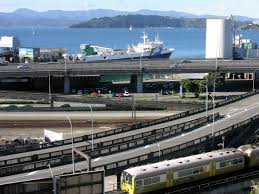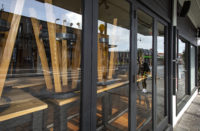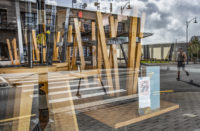
$7 billion in projects have been announced as part of the Government’s $12 billion New Zealand Upgrade Programme, which will see capital spending at its highest rate in more than 20 years, Jones said. Further significant investment in regional New Zealand will be announced in coming weeks.
“Everybody knows New Zealand has a serious deficit in infrastructure, particularly in the regions, but this Government has laid the groundwork which makes addressing this shortfall possible,” Jones said.
“Removing the common roadblocks which frustrate the delivery of major projects was a major driver behind establishing the Infrastructure Commission – Te Waihanga.”
Since its establishment late last year the Commission has already released a pipeline of major capital works, provided advice on project delivery, and begun work on a 30 year infrastructure strategy.
More than $2.8 billion has been dedicated to regional roads and rail, including $817 million for the Otaki to North of Levin road, $692m for SH1 Whangarei to Port Marsden, and $34m for rural intersection improvements in Canterbury, while regional schools and health facilities have also received a boost.
“Those in the infrastructure sector know they now have a Government making it easier to get on with what they do best – building the schools, hospitals, roads, rail, and other networks we rely on as the backbone of the economy and our day to day lives, said Jones.
“That’s why New Zealanders can have confidence we will deliver on not only today’s announcements, but more broadly on the near $50 billion in capital spending forecast for the next five years. This is great news for jobs and growth.”
Today also saw a strong focus on regional infrastructure, with a number of major provincial transport projects supported.
The New Zealand Taxpayers’ Union’s Louis Houlbrooke had several questions to ask of Finance Minister Grant Robertson.
“Grant Robertson just spent nearly $7000 per Kiwi household in a single announcement,” said Houlbrooke.
“However, we have to say the quality of spending is better than we had feared. Most of the transport funding has been allocated to highly-demanded roading projects.
“Let’s not kid ourselves however that this is a free lunch. The Government needs a greater focus on cutting wasteful spending to pay for infrastructure, rather than relying solely on borrowing.”
Houlbrooke said it was concerning that some of the projects do not have firm dates attached.
“After two-and-a-half years Jacinda Ardern’s Government has realised it has no infrastructure ideas of its own that it can deliver on, so it has copied the plans I put in place when I was Transport Minister.
“It’s quite flattering, really. It’s just a shame that an entire term of Government has been wasted by tearing up these plans and putting them back together again.”
Bridges said the damage has already been done.
“The two-year pause on starting these roads has seen our construction workforce go overseas in search of work. We’ll struggle to get them back now. This is a tragic wasted opportunity,” said Bridges.
“The Government is clearly panicking. New Zealand’s infrastructure pipeline rusted up on its watch while it focused on KiwiBuild and light rail, which have both failed spectacularly.
“The problem now is that Labour is first-class at announcements but third-rate at delivering on them. We won’t see spades in the ground anytime soon.
“They clearly don’t believe in these projects. Labour and the Greens rallied against many of them while in Opposition. The lack of detail released around so-called ‘improvements’ is also concerning. Having promised a campaign based on facts, it’s a real shame.
“National will build the infrastructure New Zealand needs and will give motorists something in return for the extra $1.7 billion this Government squeezed out of them through fuel tax hikes and extra GST.
“National will release a comprehensive infrastructure plan later this year, setting out our vision to get this country moving.
“Unlike Labour, National is the party of infrastructure and we will deliver.”
“The Government’s $12 billion infrastructure programme is a fantastic start towards building the infrastructure New Zealand needs to realise its potential,” says Infrastructure New Zealand CEO Paul Blair.
The Government announced the details for over $7 billion of its $12 billion in infrastructure spending today. Transport investments were made across New Zealand’s growth areas, with $5.3 billion allocated to road corridors (including accompanying cycle- and footpaths), $1.1 billion to rail, and nearly $400 million on the Skypath and Seapath for cycling and walking across Auckland’s Waitematā Harbour.
The announcements also included $300 million for health facilities, the previously announced $400 million for schools, and a portion of the promised $200 million for decarbonising heating at hospitals and schools.
“The infrastructure sector has been crying out for investment and a long-term pipeline, which this package delivers. The new partnership approach outlined in the Construction Sector Accord is now absolutely critical to move these plans off the page and into the hands of Kiwis,” says Blair.
Announcements about how the $4 billion Multi-Year Capital Allowance will be spent can be expected at the May Budget and the Auckland Light Rail decision is expected soon.
“The additional spending and multi-year nature of the package should provide the sector with the confidence to ramp up recruitment, training, and capital investment, with more yet to come,” says Blair.
“Te Waihanga – the NZ Infrastructure Commission – will be producing a long-term infrastructure strategy for New Zealand within the next two years that we expect will reveal tens of billions of infrastructure need across the country.
“Our water, schools, hospitals, climate resilience, defence, and housing infrastructure all have significant needs.
“Today’s announcements show central government’s funding power, however local government owns 40 per cent of our infrastructure and largely control RMA processes which are critical to delivering projects.
“We call for enhanced partnership between central and local government (including the right funding and incentives), to maximise the effectiveness of this top-down investment.
“The time is right to move our attitude from infrastructure ‘costs’ to ‘investments.’ With a strong fiscal position and low borrowing costs, there has never been a better time for a long-term, multi-partisan approach to investing in New Zealand’s future wellbeing,” says Blair.



